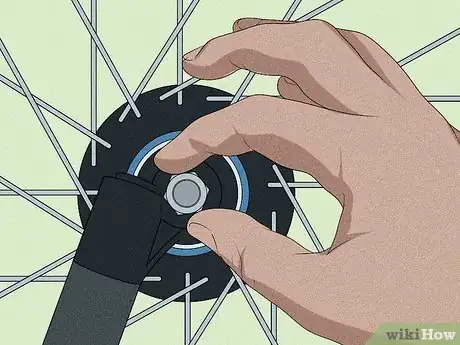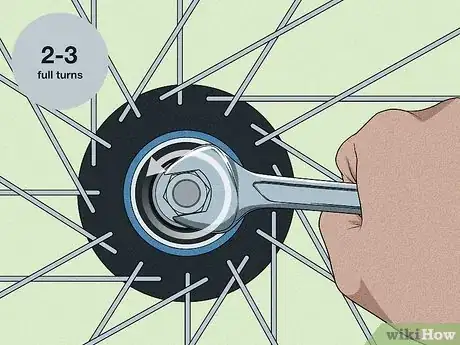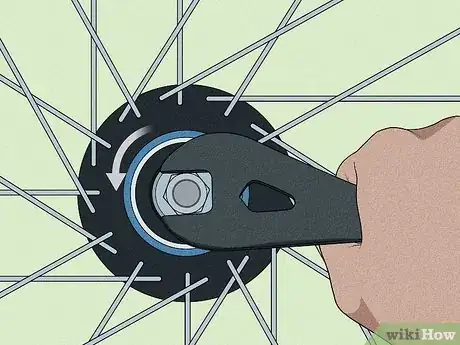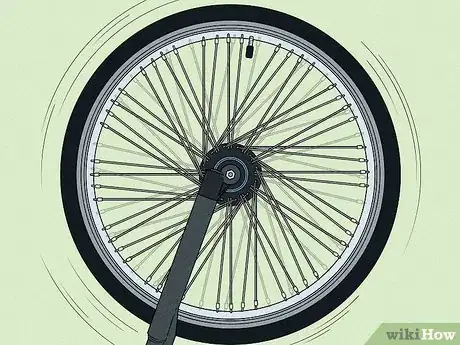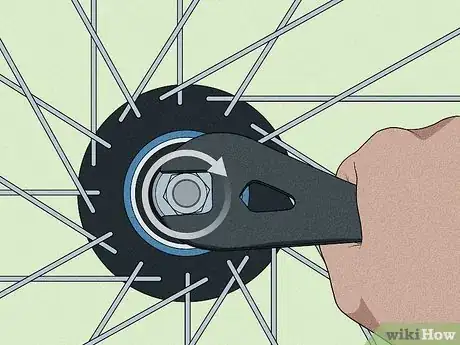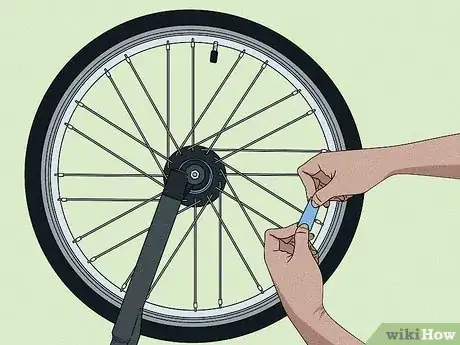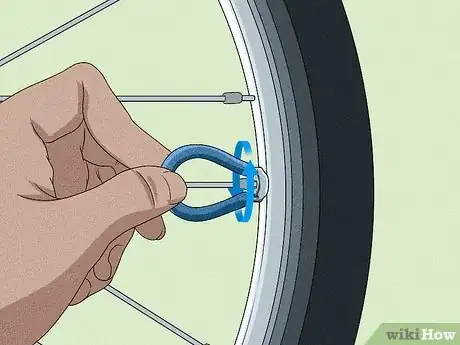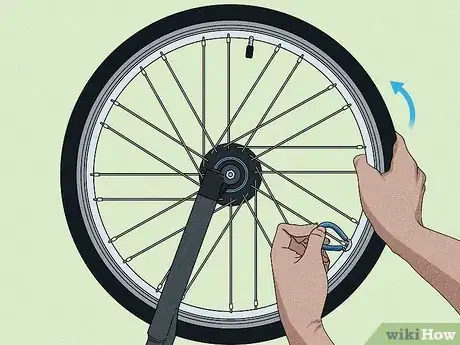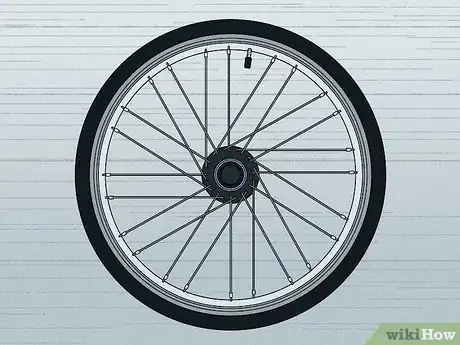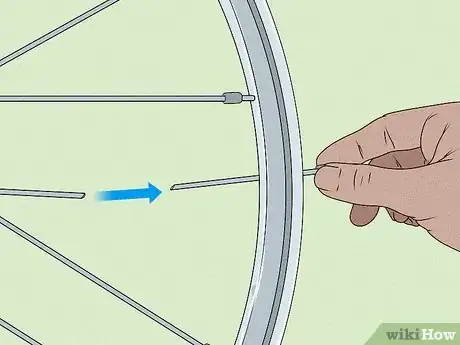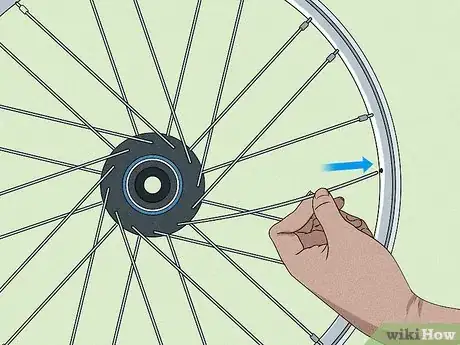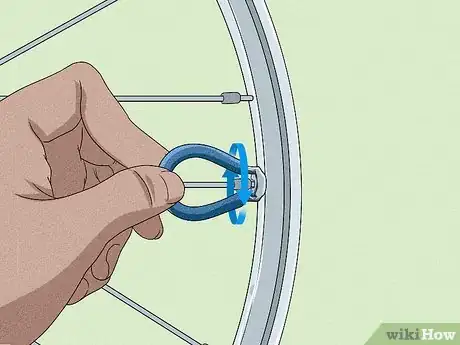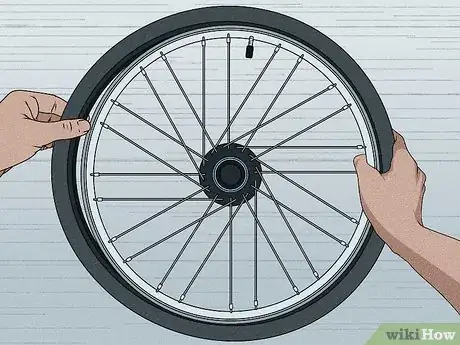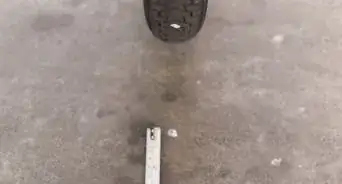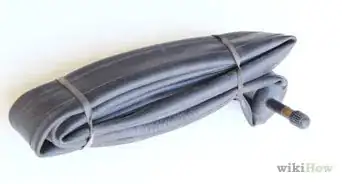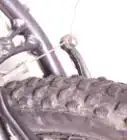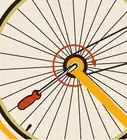This article was co-authored by wikiHow staff writer, Hunter Rising. Hunter Rising is a wikiHow Staff Writer based in Los Angeles. He has more than three years of experience writing for and working with wikiHow. Hunter holds a BFA in Entertainment Design from the University of Wisconsin - Stout and a Minor in English Writing.
There are 12 references cited in this article, which can be found at the bottom of the page.
This article has been viewed 64,770 times.
Learn more...
Over time, bike wheels will start to wear and require maintenance to keep them safe to ride. If your wheel doesn’t spin well, then you may need to adjust the cones and bearings to make your ride smoother. When your rim is bent or it wobbles, you can tighten and loosen the spokes to straighten, or “true,” it. If one of your spokes breaks, installing a replacement is necessary before you can ride it again. Once you fix your bike, you’ll be able to ride it again!
Steps
Adjusting the Cones
-
1Take the wheel off of the frame. Disconnect the brakes on the wheel you’re removing so it doesn’t get stuck. Turn your bike upside-down so you can easily access the tire. Find the screw in the middle of the wheel’s axle and rotate it counterclockwise by hand to loosen it from the wheel. Once the screw is loose, pull it out from the frame to remove it.[1]
- Set the handlebars on a towel if you’re worried about them getting scratched.
- If you’re removing the back wheel, you may have to disconnect the chain.
-
2Loosen the locknut from the wheel’s axle. Look in the center of the bike wheel and locate the hexagonal locknut attached to the axle. Grip the nut with an open end wrench and hold the axle in place with another wrench. Rotate the locknut counterclockwise by 2-3 full turns.[2]
- Many bike multi-tools have open end wrenches on them.
- If you’re adjusting the cone on the rear wheel, choose the side of the wheel opposite of the gears.
Advertisement -
3Use a cone wrench to tighten or loosen the cone. The cone is the piece attached to the axle between the locknut and the bearings. Grip the body of the cone with a cone wrench and rotate it clockwise if your wheel spins too easily or counterclockwise if it’s difficult to spin. Only rotate the cone by a quarter turn at a time so you don’t accidentally make it too tight or loose.[3]
- You can buy a cone wrench from a sporting goods store or a bike shop.
- Make sure you use a cone wrench that matches the size of your cone or else you may not be able to make your adjustment.
-
4Check if the wheel spins smoothly. Set the wheel back in the frame and spin it to see how smoothly it rotates. If your wheel is still too sticky or loose, take it out of the frame and adjust the cone again until it spins correctly.[4]
- Always make your adjustments a quarter turn at a time so you don’t damage the bearings or cones.
-
5Tighten the locknut back against the cone. Once you have your adjustment just right, turn the locknut clockwise by hand until it presses up against the cone or spacer. When the locknut is hand-tight, hold the cone in place with your cone wrench and tighten the locknut by an eighth turn to secure it.[5]
Tip: The cone may slightly tighten once you secure the locknut in place. If it feels too tight, take the locknut off again and make the cone slightly looser than what you had it before.
Truing Your Bike Wheel
-
1Locate the bend in the rim. Turn your bike upside-down so you can easily access and spin the wheels. Spin the wheel slowly and watch near the brakes to see how far the rim is bent away from them. Make note of the area where the bend is the largest by attaching a piece of tape to the nearest spoke.[6]
- Leave your wheel on your bike frame so you can easily spin it and see where the bend is.
- If your rim is severely bent and you can’t spin it in the frame, you will need to replace it.
-
2Tighten the spokes on the opposite side as the bend. Determine whether the rim is bent toward the left or the right. If the rim is bending toward the right, then find the spoke closest to the bend that’s on the left side of the wheel. Grip the spoke with a spoke wrench and rotate it counterclockwise to tighten it. Only tighten it by a half turn at a time so you don’t damage it.[7]
- You can get a spoke wrench from a sporting goods store, a bike shop, or online.
- Don’t force the spoke if it doesn’t rotate or spin since you could break it.
-
3Loosen the spokes that are on the same side as the bend. If the rim bends to the right, then locate the 1-2 closest spokes to the bend. Grip anywhere on the spokes with your spoke wrench and turn them clockwise to loosen them. Only rotate the spokes by a half turn at a time so you don’t over-adjust.[8]
- Make sure all of your spokes have an even amount of tension or else your rim will be crooked.
-
4Spin the wheel to see if it rotates smoothly. As you adjust the spokes, rotate the wheel and watch how far the rim bends away from the brakes. Tightening and loosening the spokes near the bend will straighten out the rim so you can ride it safely again. Keep making any adjustments until the wheel doesn’t bend anymore.[9]
- Take your bike or wheel into a bike shop after you fix it to make sure the rim is still safe to ride.
Tip: If there’s a large bend in the rim and you’re on the road or the trail, take the wheel off your bike and hit the bent area of the rim on a hard surface to bend it in the right direction. Try to get it as straight as possible before adjusting the spokes.
Replacing a Broken Spoke
-
1Take the wheel off of your bike. Disconnect the brakes from the wheel you’re removing. Flip your bike upside-down and set it down on the saddle and handlebars. Locate the screw in the middle of the wheel and turn it counterclockwise by hand to loosen it. Pull the screw out of the wheel and then pull the wheel out of the bike frame.[10]
- If you’re fixing a spoke on the rear wheel, then you also need to remove the gear cassette.
-
2Remove the tire, tube, and rim tape from the wheel. Let out all the air from the tie by pressing down on the tire valve. Once it’s deflated, shimmy a tire lever between the tire and the rim. Pull the tire lever down to pop the tire and tube out of the rim, and then pull it off of the tire by hand. Locate the strip of rim tape on the inside of the rim and pull it off to remove it.[11]
- Don’t try to remove the tire when the tube is still inflated since you could pop or damage it.
-
3Pull the broken spoke out from the wheel. Locate where the spoke connects to the outside of the rim and use a screwdriver to remove the nipple, which is the piece holding the end of the spoke in place. Then grab the spoke near the center of the wheel and pull it toward the center. The spoke will easily slide out from the holes when you remove it. Throw the old spoke away since you can’t use it anymore.[12]
- Some spokes are straight while others what a J-shaped hook. If the spoke has a hook on the end, be careful when you remove it so it doesn’t accidentally catch on other spokes.
Warning: If one of your spokes broke due to old age, the other spokes on your wheel may break soon as well. Either replace all of your spokes or get a replacement wheel.
-
4Thread the new spoke through the holes onto the rim. Put the threaded end of the spoke through the hole closest to the center of the wheel. Look at the pattern of your spokes to see if the new spoke needs to go over or under other spokes while you’re threading it in. Guide the threaded end of the spoke through the hole on the outside of the rim.[13]
- You can buy new spokes from bike repair shops or sporting goods stores.
- Make sure the spoke you have is the same length and style as the old one or else it won’t fit your bike properly.
-
5Screw the spoke nipple onto the threaded end of the spoke. Feed the threaded end of the spoke onto the nipple and guide the nipple through the hole in the rim. Rotate the nipple clockwise by hand to tighten it and secure it to the spoke. Once the nipple is hand-tight, use a screwdriver to spin it a quarter turn so you don’t overtighten it.[14]
- Use the spoke nipple from the old spoke so you don’t have to buy a new one.
-
6Tighten the spoke nipple with a spoke wrench to add tension to it. Grip the end of the spoke nipple sticking out from the rim with your spoke wrench and rotate it clockwise to tighten it. Compare the tension on the new spoke with the other spokes near it and keep adjusting until they feel the same.[15]
- You can also grab the spoke directly if it’s easier than the spoke nipple.
-
7Put the rim tape, tube, and tire back onto the bike. Apply a layer of rim tape around the outside of the rim so the ends of the spokes don’t damage the tube and tire. Slightly inflate the tube before threading it into the tire. Line up the valve stem on the tire with the hole on the rim and push the tire and tube back onto the wheel. Inflate the tube again to secure it in place.[16]
- You can buy rim tape from a bike shop or sporting goods store.
Community Q&A
-
QuestionHow can I fix my cat RIM?
 Community AnswerYou need to replace the hoop of the wheel, replace the spokes or rim, or just buy a whole new wheel.
Community AnswerYou need to replace the hoop of the wheel, replace the spokes or rim, or just buy a whole new wheel.
Warnings
- Even if you made the fix yourself, have the wheel checked at a bicycle repair shop to see if it’s still safe to ride.⧼thumbs_response⧽
Things You’ll Need
Adjusting the Cones
- Open end wrench
- Cone wrench
Truing Your Bike Wheel
- Tape
- Spoke wrench
Replacing a Spoke
- Wrench
- Tire lever
- Screwdriver
- Spoke
- Spoke nipple
- Spoke wrench
- Rim tape
References
- ↑ https://www.sportsrec.com/343596-adjust-bicycle-wheel-bearings.html
- ↑ https://www.sportsrec.com/343596-adjust-bicycle-wheel-bearings.html
- ↑ https://www.sportsrec.com/343596-adjust-bicycle-wheel-bearings.html
- ↑ https://www.sportsrec.com/343596-adjust-bicycle-wheel-bearings.html
- ↑ https://youtu.be/uQJm43eCpWo?t=33
- ↑ https://youtu.be/xx-qJttZz4s?t=21
- ↑ https://youtu.be/Eg9ZfzLnTl0?t=396
- ↑ https://youtu.be/Eg9ZfzLnTl0?t=396
- ↑ https://youtu.be/xx-qJttZz4s?t=73
